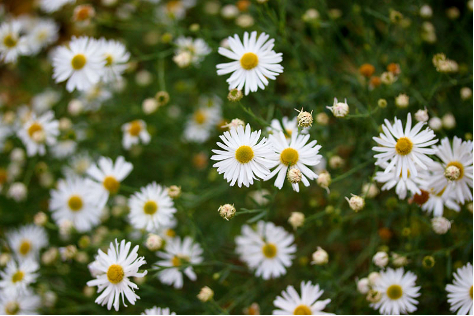Boltonia asteroides: Boltonia
 Latin name: Boltonia asteroides
Latin name: Boltonia asteroides
Common name: Boltonia, White Doll’s Daisy
Flowers: Small white blooms from August to October 10
Fruit: N/A 10, 12
Height & Width: 5-6’ x 2-4’ 12
Type: Herbaceous perennial 10
Habit: Upright 4
Wetland indicator category**: FACW, OBL 17
Texture: Fine 4
Growth rate: Medium 4
Light: Full sun 12
Moisture: Medium 12
Soil*: Acidic, rich, also tolerates clay 10
Zones: 3-10 12
Origin: East and Mid USA 16
Ecosystem benefits: Attracts butterflies 10
Features: These flowers are showy in the fall and attractive to butterflies 10.
Siting: Boltonia adds color to any fall garden and tolerates a wide range of soils.
Care: Plant crown at soil level 18. At planting, water the roots and surrounding area slowly and deeply. Keep soil moist until the plant is established, then apply enough water to thoroughly moisten the root zone when the soil is dry or during drought. Modify water recommendations to reflect site drainage and rainfall. Apply 3” of mulch over the planted area. Do not allow mulch to touch the plant stems 18.
Pests: Plants are relatively pest resistant if cultural preferences are 18
This plant does not appear on the following invasive plant lists on 10/25/2020:
USDA SC Invasive Plant Species
SC Exotic Plant Pest Council
Author: Hannah Grace Coker
Image source: https://www.gardenia.net/plant/boltonia-asteroides
Sources:
- Armitage, A. (2001). Armitage’s manual of annuals, biennials, and half-hardy perennials. Portland, OR: Timber Press.
- Armitage, A. (2006). Armitage’s native plants for North American gardens. Portland, Oregon: Timber Press.
- Armitage, A. (2008). Herbaceous perennial plants: A treatise on their identification, culture, and garden attributes. Athens, GA: University of Georgia.
- Clemson Cooperative Extension Home and Garden Information Center.(2011). Flowers fact sheets. Retrieved from http://www.clemson.edu/extension/hgic/plants/landscape/ flowers/
- Clemson Cooperative Extension Home and Garden Information Center.(2011). Groundcovers & vines fact sheets. Retrieved from http://www.clemson.edu/ extension/hgic/plants/landscape/groundcovers/
- Clemson Cooperative Extension Home and Garden Information Center.(2011). Trees. Retrieved from http://www.clemson.edu/extension/hgic/ plants/landscape/trees/
- Clemson Cooperative Extension Home and Garden Information Center.(2011). Shrubs. Retrieved from http://www.clemson.edu/extension/hgic/plants/landscape/shrubs/
- Dirr, M. A. (2009). Manual of woody landscape plants. Champaign, IL: Stipes Publishing.
- Gilman, E. F. (1997). Trees for urban and suburban landscapes. Albany, NY: Delmar Publishers.
- Lady Bird Johnson Wildflower Center University of Texas at Austin. (2012). Native plant information network. Retrieved from http://www.wildflower.org/explore/
- McMillan, P., Plant taxonomist Clemson University, personal communication.
- Missouri Botanical Garden Kemper Center for Home Gardening. Plant finder. Retrieved from http://www.mobot.org/gardeninghelp/plantfinder/Alpha.asp
- North Carolina State University (2005). Plant fact sheets. Retrieved from http://www.ces.ncsu.edu/depts/hort/consumer/factsheets/index.html
- Strother, E. V., Ham, D. L., Gilland, L. (2003) Urban tree species guide: Choosing the right tree for the right place. Columbia, SC: South Carolina Forestry Commission.
- University of Florida, IFAS Extension. (2011). Southern trees fact sheet. Retrieved from http://edis.ifas.ufl.edu/department_envhort-trees
- USDA . Plant profile. (n/d).Retrieved from http://plants.usda.gov/java/
- USDA. Plant wetland indicator status. (n/d). Retrieved from http://plants.usda.gov/wetland.html
- Vincent, E., Environmental horticulturist Clemson University, personal communication.
- Clemson Extension. Carolina Yards Plant Database. Retrieved from https://www.clemson.edu/extension/carolinayards/plant-database/index.htm
*Soil pH is determined using a professional soil test. Contact your Clemson University County Extension service for assistance www.clemson.edu/extension/. Click on “local offices”.
**2012 Plant Wetland Indicator categories (quantitative derived) http://plants.usda.gov/wetinfo.html
| Indicator Code | Indicator Status | Comment |
|---|---|---|
| OBL | Obligate Wetland | Almost always is a hydrophyte, rarely in uplands |
| FACW | Facultative Wetland | Usually is a hydrophyte but occasionally found in uplands |
| FAC | Facultative | Commonly occurs as either a hydrophyte or non-hydrophyte |
| FACU | Facultative Upland | Occasionally is a hydrophyte but usually occurs in uplands |
| UPL | Obligate Upland | Rarely is a hydrophyte, almost always in uplands |
